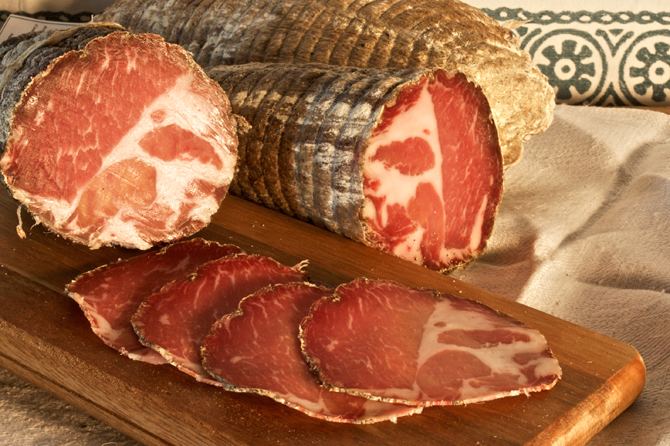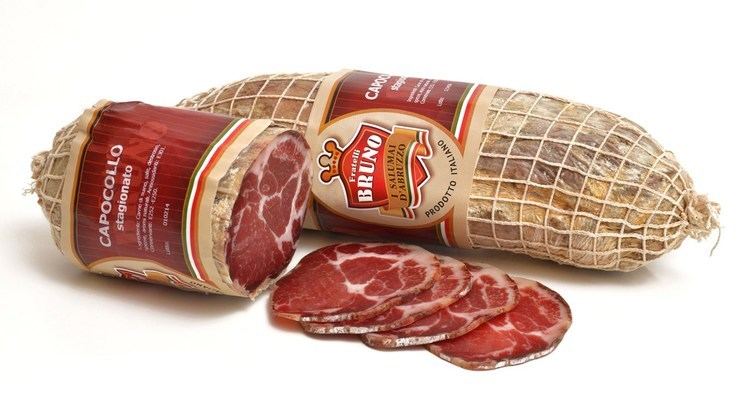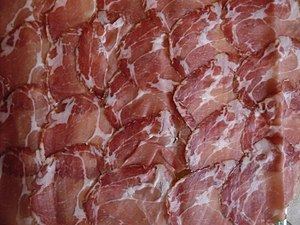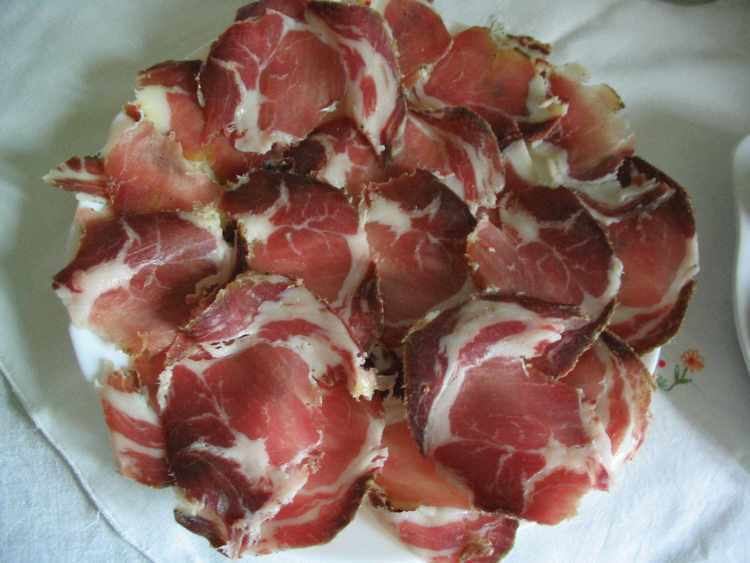Similar Pancetta, Bresaola, Mortadella, Soppressata, Prosciutto | ||
Capocollo making at the infusino s a 3 part pork series with frank mazzuca family style
Capocollo ([kapoˈkɔllo]) or coppa ([ˈkoppa]) is a traditional Italian and Corsican pork cold cut (salume) made from the dry-cured muscle running from the neck to the 4th or 5th rib of the pork shoulder or neck. It is a whole muscle salume, dry cured and, typically, sliced very thin. It is similar to the more widely known cured ham or prosciutto, because they are both pork-derived cold-cuts that are used in similar dishes. However, it is not brined as ham typically is.
Contents
- Capocollo making at the infusino s a 3 part pork series with frank mazzuca family style
- Making capicola in 5 minutes
- Terminology
- Manufacture and use
- Varieties and official status
- References

Making capicola in 5 minutes
Terminology
This cut is typically called capocollo or coppa in much of Italy and Corsica. This name is a compound of the words capo ("head") and collo ("neck"). Regional terms include capicollo (Campania), capicollu (Corsica), finocchiata (Tuscany), lonza (Lazio) and lonzino (Marche and Abruzzo).

Outside of Italy and Corsica, terms include bondiola or bondiola curada in Argentina and capicola or capicolla in North America. The slang term gabagool has been used by Italian Americans in the New York City area. It was notably used in the television series The Sopranos and its use has become a well-known humorous stereotype.
Manufacture and use

In its production, capocollo is first lightly seasoned often with red and sometimes white wine, garlic, and a variety of herbs and spices that differ depending on region. The meat is then salted (and was traditionally massaged) and stuffed into a natural casing, and hung for up to six months to cure. Sometimes the exterior is rubbed with hot paprika before being hung and cured. Differences in flavor also depend on what type of wood the producer uses for smoking, and the breed of pig. Capocollo is essentially the pork counterpart of the air-dried, cured beef bresaola. It is widely available wherever there are significant Italian communities, thanks to commercially produced varieties. There is also a slow-roasted Piedmontese version called coppa cotta.

Capocollo is esteemed for its delicate flavor and tender, fatty texture and is often more expensive than most other salumi. In many countries, it is often sold as a gourmet food item. It is usually sliced thin for use in antipasto or sandwiches such as muffulettas, Italian grinders and subs, and panini as well as some traditional Italian pizza.
Varieties and official status
Two particular varieties, Coppa Piacentina and Capocollo di Calabria, have Protected Designation of Origin (P.D.O.) status under the Common Agricultural Policy of European Union law, which ensures that only products genuinely originating in those regions are allowed in commerce as such.
Four additional Italian regions produce capicollo, and are not covered under European law, but are designated as "Prodotto agroalimentare tradizionale" (P.A.T.) by the Italian Ministry of Agricultural, Food and Forestry Policies:
Outside Italy, capocollo is traditionally produced also in the French island of Corsica under the names of coppa or capicollu. Coppa di Corsica/de Corse is also a P.D.O. product. It was introduced to Argentina by Italian immigrants, under the names "bondiola" or "bondiola curada".
